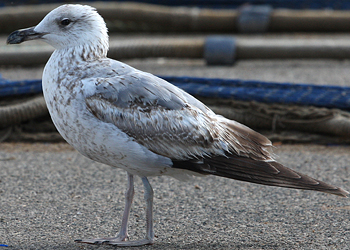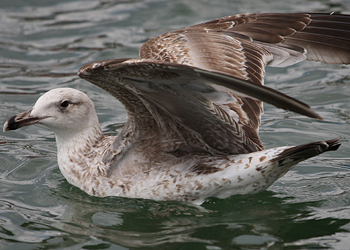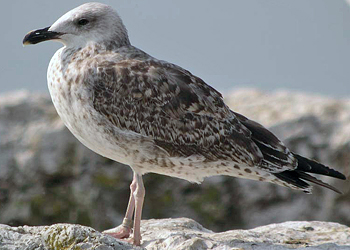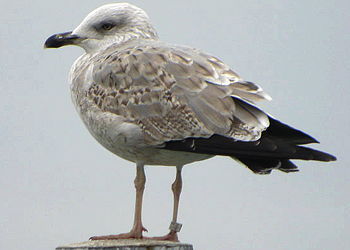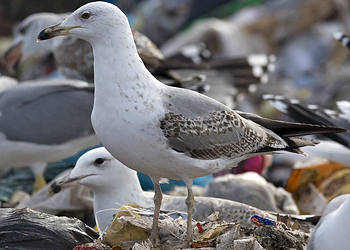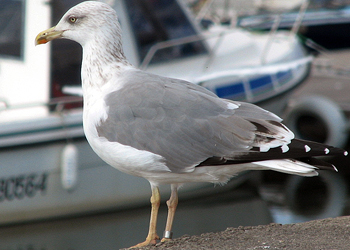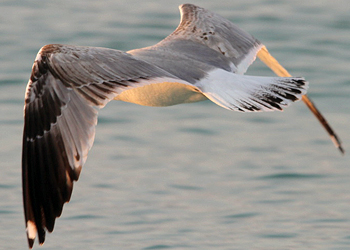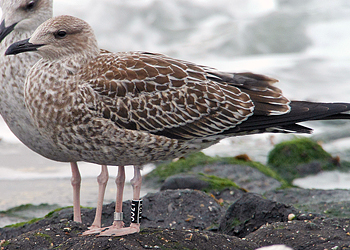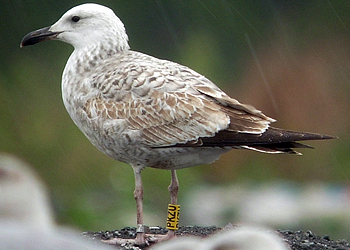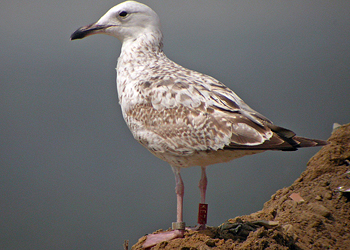 Herring Gull- Zilvermeeuw (argentatus & argenteus)
Herring Gull- Zilvermeeuw (argentatus & argenteus)
(last update: December 15, 2011
Herring Gull - 4cy /sub-adults June
Yellow-legged gulls and yellow-legged Herring Gulls in the Baltic
LARS JONSSON - Alula 3/1998
 This is a copy of the article "Yellow-legged gulls and yellow-legged Herring Gulls in the Baltic", by Lars Jonsson and published in Alula 3, 1998. "I" in the text refer to the author Jonsson. We also reproduced some tables and figures from this article, but also added many, many more images from especially ringed birds to illustrate Lars's article. We did our best to be very precise, but if you find any errors, please let me know at marsmuusse at gmail dot com.
This is a copy of the article "Yellow-legged gulls and yellow-legged Herring Gulls in the Baltic", by Lars Jonsson and published in Alula 3, 1998. "I" in the text refer to the author Jonsson. We also reproduced some tables and figures from this article, but also added many, many more images from especially ringed birds to illustrate Lars's article. We did our best to be very precise, but if you find any errors, please let me know at marsmuusse at gmail dot com.
PART 1: Taxonomy & Nomenclature
PART 2: Field identification
PART 3: Caspian Gull
PART 4: Caspian Gull plumages
PART 5: Yellow-legged Gull
below: PART 6:
Yellow-legged Gull plumages (last part)
Yellow-legged gulls and yellow-legged Herring Gulls in the Baltic
LARS JONSSON - Alula 3/1998
Yellow-legged Gull L. michahellis - subsequent plumages
The development into full adult plumage is generally completed by the time the third set of flight feathers is acquired, which means the autumn of the fourth calendar-year. In the autumn of the third calendar-year the sitting bird can already look almost like an adult and only brown marks on the primary coverts and dark markings on the bill reveal its immaturity.
First-summer
During the winter, early in its second calendar-year, it seems as if a variable amount of feathers are moulted for the second time (first pre-breeding moult), at least on some birds; these new feathers are quite similar to the first-winter ones, although some are cleaner grey at the base, giving a colder and smoother impression, but they are only rarely predominately grey. In mid-summer (while the flight feathers are being moulted) the upperparts are typically variegated and contrasting, with many intricate stripes, bars and dark blotches on scapulars and wing coverts, basically resembling argentatus, but more boldly patterned. Only a smaller percentage (ca. 20% in Hungary in late July) acquires unmarked grey scapulars. On average the head is lighter than on argentatus, but the dusky mask around the eye is typical throughout the second calendar-year. Cachinnans is usually more obviously white-headed at this age and acquires more or less white underwing coverts. By mid-summer of its second calendar-year, graellsii has acquired darker grey bases to many of scapulars (which also occurs in some atlantis) giving it an overall darker impression. Argentatus and cachinnans remain the most obvious confusion risk. Michahellis more often retains a dark iris at this age whereas argentatus commonly acquires a visibly lighter iris during the second winter (but can certainly be dark-eyed up to an almost adult stage).
Second-winter plumage
Second-winter (2nd – 3rd cy) birds are quite variable; many are still very immature looking in late summer / early autumn with much dark on the bill and strongly marked/barred wing coverts and scapulars. It seems that many others acquire plainer grey feathers later in the autumn (September-October?) on the mantle and scapulars, as well as median wing coverts. At least in the Baltic, argentatus never acquires plain grey wing coverts in the autumn of their second calendar-year. The great majority of argentatus does not show any plain grey feathers before around February of their third calendar-year, and even in the autumn of their third calendar-year they still have some dark-patterned scapulars. The underwing coverts are always well marked with brown in this plumage whereas in cachinnans it is usually almost white or has only fine rows of small spots.
Second-summer - third-winter plumage
The second pre-breeding moult may start as early as December, but at the latest by mid February the saddle in the vast majority of birds has become perfectly grey (fig. 23) and the head white. By March only few birds still show streaks on the head and a few brown-patterned feathers on the scapulars. The bill usually becomes lighter, dirty yellowish to clear yellow, with a black band or patch near the tip bordered with orange at the gonys. Birds in the summer of their third calendar-year all progress from a more or less immature look to an appearance more like that of an adult. They will however still have brownish outer greater primary coverts, reduced white on the wingtip and some still have dark vermiculation on a few tail feathers. Many third-winter birds may show some dark-smudged underwing coverts, like argentatus. The bill colour obviously regresses to become darker again after the breeding season.
Behaviour and vocalisation
Cachinnans is often dominant over argentatus when the two feed together. A few authors have described Finnish-ringed argentatus as being very dominant. This is possibly related to size, male cahinnans often being very big and the same may apply to some of the inland breeding argentatus in the Fenno-Baltic area. Cachinnans demonstrates its position by frequently stretching its wings and calling with the head raised vertically. This position, reminiscent of an albatross, is typically used during the longcall (see fig. 37). Argentatus and michahellis are less inclined to demonstratively raise their wings, but in close struggles for food or just after landing in a breeding colony, the wings can be lifted for a short time. Michahellis and cachinnans share with fuscus the very deep bow during the first phase of the longcall as well as the vertically raised head in its second part. Argentatus tends to stretch up the head at an angle of 45°. Both fuscus and michahellis however occasionally also call with a more argentatus-like angle. Any behavioural characteristics are usually of little value as fieldmarks if only observed once, but when a certain trait is persistently executed it can be a strong species indication.
Cachinnans has a peculiar, nasal sound to its voice; the longcall is faster, more of a staccato, and deeper and more nasal than that of argentatus. Larus cachinnans means the laughing gull and this is still the name in use in the Russian language.
Michahellis has a longcall which is close to fuscus in tone and rhythm. To my ear it is obviously slower than in cachinnans and deeper and more nasal than in argentatus, the longcall of which has a clearer and more musical voice.
Identification problems with other gulls: Lesser Black-backed Gull L. fuscus (Linne 1758)
Nominate fuscus of the Baltic Sea, northern Norway, Finland and the White Sea is, in adult plumage, unlikely to be ever mistaken for either cachinnans or michahellis, but in juvenile plumage they are more similar. The same can be said of intermedius of western Scandinavia and graellsii of Britain, Ireland and Iceland. Juvenile and first-winter graellsii especially can be very difficult to tell from michahellis and some individuals may be impossible to identify. The occurrence of the odd graellsii in the Baltic should not, however, in practise give rise to significant problems; it is clearly the odd argentatus that causes the most confusion here.
Identification problems with other gulls: Tundra/Siberian Gull L. heuglini (Bree 1876)
I do not intend to cover the identification of this form in any detail here. The regular presence of L. heuglini in Finland has become obvious over the past few years (Eskelin & Pursiainen 1998). This is not surprising, given the close proximity of the breeding grounds on the shores of the White Sea.
Adult heuglini shows a mantle colour usually varying between 9.0-10.0 (8.5-10.5) on the Kodak Grey Scale and is therefore unlikely to be confused with any of the light-mantled forms. Problems in distinguishing heuglini from michahellis and cachinnans respectively are most likely to arise in the case of immature birds which completely lack grey feathers in the mantle or scapulars. Theoretically juvenile heuglini could present an identification problem vis-a-vis cachinnans and michahellis; in practice however, by the time the first juvenile heuglini appears, in a perfect fresh plumage (September-October), the other two forms are considerably more advanced in moult and wear. Until an actual case arises I think this problem can be left aside.
In the spring the scene regarding misidentifying vagrant heuglini is somewhat different. Returning or wandering first-summer individuals of cachinnans, michahellis, heuglini, graellsii and possibly barabensis can due to large individual differences be very difficult to tell apart. The structural difference is always there but plumage wise heuglini and some cachinnans may be difficult to tell apart.
Acknowledgements
Many omithologist and friends have contributed to this article by supplying valuable information, photographs and general support. Especially thanks to Kenneth Bengtsson, Andrés Bermejo, Christian Cederroth, Martin Elliot, Jens & Hanne Eriksen, Andrei Filchagov, Goran Frisk, Eddie Fritze, Annika Forsten, Martin Gamer, Martti Hario, Andreas Helbig, Eric Hirschfeld, Ronald Klein, Dorit Liebers, Howard King, Hans Larsson, Harry J. Lehto, Henry Lehto, Klaus Malling Olsen, Dave McAdams, Killian Mullamey, Kjeld Pedersen, Pertti Saurola, Torsten Stjemberg, Ante Strand, Lars Svensson, Norman van Swelm, Lars Tydén and many more.
References (see PDF)
 Herring
Gull (argenteus) GC 89668 4cy, April-August 2011, Leiden, Netherlands.
Herring
Gull (argenteus) GC 89668 4cy, April-August 2011, Leiden, Netherlands. Herring Gull (argenteus) MHAD 2CY & 4CY, March 2011 & June 2013, Koksijde, Belgium & Noordwijk, the Netherlands. Picture: Peter Adriaens & Frank van der Meer.
Herring Gull (argenteus) MHAD 2CY & 4CY, March 2011 & June 2013, Koksijde, Belgium & Noordwijk, the Netherlands. Picture: Peter Adriaens & Frank van der Meer. Herring
Gull PBAF 4cy (argenteus), June 08 2013, Noordwijk, the Netherlands.
Herring
Gull PBAF 4cy (argenteus), June 08 2013, Noordwijk, the Netherlands. Herring Gull (argenteus) YBMD 1CY-4CY, August 2013 - June 2016, IJmuiden, the Netherlands.
Herring Gull (argenteus) YBMD 1CY-4CY, August 2013 - June 2016, IJmuiden, the Netherlands. Herring Gull (argenteus) Y.BPS 4CY, June 02 2014, IJmuiden, the Netherlands. Picture: Maarten van Kleinwee.
Herring Gull (argenteus) Y.BPS 4CY, June 02 2014, IJmuiden, the Netherlands. Picture: Maarten van Kleinwee. Herring Gull (argenteus) K.BMF 1CY-4CY, September 2014 - June 2017, Den Haag - Scheveningen - Heemskerk, the Netherlands.
Herring Gull (argenteus) K.BMF 1CY-4CY, September 2014 - June 2017, Den Haag - Scheveningen - Heemskerk, the Netherlands.  Herring
Gull 5.419.235 4cy (argenteus), 2009-2011, Leiden, Netherlands.
Herring
Gull 5.419.235 4cy (argenteus), 2009-2011, Leiden, Netherlands. Herring Gull (argenteus) NLA 5.465.212 4CY, June 26 2017, Katwijk, the Netherlands.
Herring Gull (argenteus) NLA 5.465.212 4CY, June 26 2017, Katwijk, the Netherlands.  Herring Gull sub-adult, June 09 2013, Noordwijk, the Netherlands.
Herring Gull sub-adult, June 09 2013, Noordwijk, the Netherlands.  Herring Gull sub-adult, June 09 2013, Noordwijk, the Netherlands.
Herring Gull sub-adult, June 09 2013, Noordwijk, the Netherlands.  Herring Gull 4CY, June 09 2013, Noordwijk, the Netherlands.
Herring Gull 4CY, June 09 2013, Noordwijk, the Netherlands. 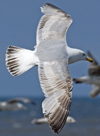 Herring Gull sub-adult, June 09 2013, Noordwijk, the Netherlands.
Herring Gull sub-adult, June 09 2013, Noordwijk, the Netherlands.  Herring Gull sub-adult, June 09 2013, Noordwijk, the Netherlands.
Herring Gull sub-adult, June 09 2013, Noordwijk, the Netherlands.  Herring Gull sub-adult, June 09 2013, Noordwijk, the Netherlands.
Herring Gull sub-adult, June 09 2013, Noordwijk, the Netherlands.  Herring Gull sub-adult, June 09 2013, Noordwijk, the Netherlands.
Herring Gull sub-adult, June 09 2013, Noordwijk, the Netherlands.  Herring Gull 4CY, June 07 2013, Noordwijk, the Netherlands.
Herring Gull 4CY, June 07 2013, Noordwijk, the Netherlands.  Herring Gull 4CY, June 10 2013, Noordwijk, the Netherlands.
Herring Gull 4CY, June 10 2013, Noordwijk, the Netherlands.  Herring Gull sub-adult, June 09 2013, Noordwijk, the Netherlands.
Herring Gull sub-adult, June 09 2013, Noordwijk, the Netherlands.  Herring Gull 4CY, June 09 2013, Noordwijk, the Netherlands.
Herring Gull 4CY, June 09 2013, Noordwijk, the Netherlands.  Herring Gull 4CY, June 09 2013, Noordwijk, the Netherlands.
Herring Gull 4CY, June 09 2013, Noordwijk, the Netherlands. 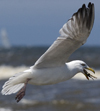 Herring Gull 4CY, June 09 2013, Noordwijk, the Netherlands.
Herring Gull 4CY, June 09 2013, Noordwijk, the Netherlands.  Herring Gull 4CY, June 07 2013, Noordwijk, the Netherlands.
Herring Gull 4CY, June 07 2013, Noordwijk, the Netherlands.  Herring Gull 4CY, June 09 2013, Noordwijk, the Netherlands.
Herring Gull 4CY, June 09 2013, Noordwijk, the Netherlands.  Herring Gull 4CY, June 09 2013, Noordwijk, the Netherlands.
Herring Gull 4CY, June 09 2013, Noordwijk, the Netherlands.  Herring Gull 4CY, June 09 2013, Noordwijk, the Netherlands.
Herring Gull 4CY, June 09 2013, Noordwijk, the Netherlands.  Herring Gull 4CY, June 09 2013, Noordwijk, the Netherlands.
Herring Gull 4CY, June 09 2013, Noordwijk, the Netherlands.  Herring Gull 4CY, June 09 2013, Noordwijk, the Netherlands.
Herring Gull 4CY, June 09 2013, Noordwijk, the Netherlands.  Herring Gull sub-adult, June 09 2013, Noordwijk, the Netherlands.
Herring Gull sub-adult, June 09 2013, Noordwijk, the Netherlands. 

